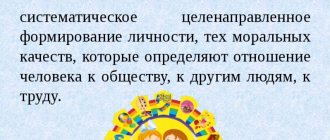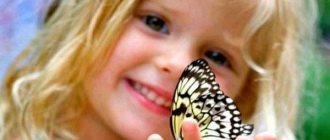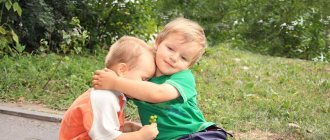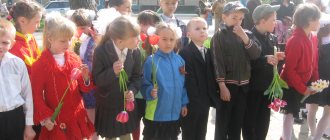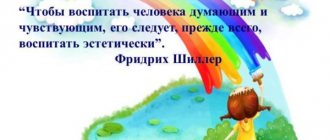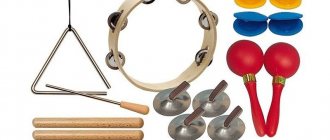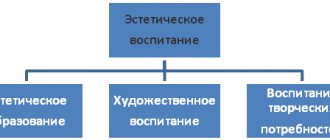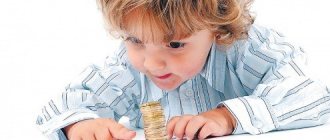A child comes into this world as a pure and innocent creature. His mind is like a foam sponge, greedily absorbing all the information around it. But we know very well that not everything that he sees is good, useful and correct. We know he doesn't. For him, the world is a priori beautiful and interesting. This is where the task arises - to teach the little open-minded creature to separate good from bad, right from wrong. Teach your child to respect each person and the whole world as a whole.
The moral education of preschool children begins at birth and continues throughout life . This concept includes basic knowledge about good and evil, rules of behavior in society, stimulating empathy and respect for others. Moral education is more a natural process than a scientific one. It is impossible to deliberately teach a child morality. You can only correct his independent path of learning the entire harmony of the world around him.
The first steps of education
Little children have no idea about morality until we give it to them. And moral education (so to speak) begins from the cradle itself. The mother gently hugs her baby and smiles, he is pleased. He understands that a smile is good, and begins to smile back at her. She gently strokes the child, kisses him - he understands that gentle touches are pleasant, and touches her in return. These are the first lessons of love and tenderness. The baby learns about what “not good” is later, when he violates the first parental prohibitions. Parents are angry - he understands that he is doing wrong. These moments only seem simple and unimportant ; in fact, this is how the formation of moral qualities begins.
As the child grows up, the child is not just told “no”, but also explained why. The word “impossible” without a logical explanation is perceived by the baby as “possible only when mother is not looking.” Parents explain why you can’t hit, why you can’t scream or offend the kitten, why you need to help the mother. Morality for a child is the difference between good and bad.
Personal example - its role in moral education
As we wrote above, children cannot be taught morality; they can only learn it from adults. Adults are an example for preschool age. Especially the example of parents. Parents are ideal for the baby . Everything they do is right and good for him by default. If a mother raises her hand to a child, and a father resolves conflicts with his fists (or worse, hits the mother), then they can tell him as much as they want that fighting is not good, but he has already taken the model of behavior from his parents, and for him it is the only correct one .
Breathing exercises for children in preschool educational institutions
For children, sources of moral education are:
- Parents;
- The adults around him (caregivers, teachers, relatives, older brothers and sisters);
- Fairy tales (especially folk tales, and not only Russian ones);
- TV and Internet;
- Environment.
Attention
Recognizing someone as an authority, the child consciously (and more often subconsciously) copies his behavior, and this, for a second, forms the foundation of his moral image. Therefore, dear parents, educators, and simply elders, be careful about your behavior if you want our future generation to be morally and spiritually educated.
Pedagogical project “Spiritual and moral education of children based on the traditions of their people”
Administration of the Saransk urban district
Department of Education
MDOU "Kindergarten No. 78 combined type"
Pedagogical project
“Spiritual and moral education of children based on the traditions of their people”
(for the 2017-2018 academic year)
Performed:
teacher of the first quarter category
Malaeva Olga Borisovna
Saransk 2017
Problem
The rejection of the younger generation from national culture, from the socio-historical experience of generations is one of the serious problems of our time. It is necessary to develop children's understanding of cultural heritage and cultivate a caring attitude towards it from preschool age.
“No one can become the son of his people if he is not imbued with those basic feelings with which the people’s soul lives. No matter how complex or dark the psychology of the national bond may be, we can, however, assert that we cannot mature outside of the national culture, which we must imbue so that the powers inherent in the soul of our soul can be developed.”
, —
wrote the famous Russian religious philosopher
.
The system of spiritual and moral education of a child is built “on” and “through” introducing him to the cultural heritage of his people. An important means of spiritual and moral education of preschool children is to introduce them to the traditions of the people.
Relevance
The topic is determined by the need of our society for the spiritual and moral education of children based on the traditions and culture of the Russian people and the peoples inhabiting Russia.
In the Education Law, spiritual and moral education is designated as one of the priority areas for the overall development of the child.
Childhood is the time when a person acquires knowledge about the world around him, the time of formation of moral skills and habits. In preschool age, there is an active accumulation of moral experience, and turning to spiritual life also begins in preschool age with moral self-determination and the formation of self-awareness. Systematic spiritual and moral education of a child from the first years of life ensures his adequate social development and harmonious personality formation.
“Education, if it does not want to be powerless, must be popular!” said K.D. Ushinsky. He introduced the term “folk pedagogy” into Russian pedagogical culture, seeing in folklore works the national identity of the people, rich material for instilling love for the Motherland.
It is probably best to introduce preschool children to folk culture through folk holidays and song and play traditions. Holidays are a special, bright, living side of folk culture, reflecting ancient traditions, rituals, and the historical experience of the people. National holidays fill a child’s life with the light of kindness and affection, enrich him spiritually, and lay the foundations of high human values. Revealing a child's personality is entirely possible through his inclusion in the culture of his own people. And this is not just knowledge about culture, but living in culture, living in tradition, through entering the annual holiday circle. Children get acquainted with folk traditions, and then bring the acquired knowledge and experience into their daily activities. The wisdom of folk culture makes them more knowledgeable in everyday situations, educates them emotionally and morally, and prepares them for the future life.
Filtering information, or the important role of television
We will not talk now about the dangers of the TV itself (computer, tablet). Doctors talk a lot about this, but we will remind you of the colossal influence that what a small viewer watches has on moral education. Any seemingly most harmless cartoon carries a semantic load . The beloved hero becomes a role model; his behavior makes adjustments to the upbringing of the preschooler. Therefore, pay attention to what your baby is watching?
In the last century, during that same Soviet era, the state solved this problem for parents with the help of Soyuzmultfilm. Everything that appeared on the screens had an educational purpose. Cartoons taught people to be kind, well-mannered, educated, and hardworking. They taught to love their homeland, love their parents, make friends and respect their elders. And even the “evil” in Soviet cartoons, for the most part, was kindly charming and funny. Do we need to remind you what the level of morality was in the country?
Today the filter and censorship were completely turned off . All kinds of monsters, ugly characters, constantly swearing, shoving, rude, ill-mannered and unkempt, look at the baby from the TV screen.
Important
Notice what information is conveyed by low-quality cartoons from cheap commercial channels?
What children see and what they take in:
- Aggression. An eye for an eye, a tooth for a tooth, and that's putting it mildly. Hit, push, throw something at someone who annoys you;
- Selfishness. Every man for himself in this world;
- Lack of compassion. Laugh if someone is hurt, pass by if someone needs help. Plus the endless pain that the heroes experience. They are beaten, a weight falls on them, they fall from a height, and there are no feelings of regret - children are asked to laugh at an animal that has fallen from a height (example);
- Cunning. To deceive, to deceive in order to achieve a goal;
- Bad manners (how I want to talk about Peppa Pig). Cartoon characters are not shy about the sounds of their bodies (and laugh fervently at this), they climb into the mud and enter without knocking.
Information and communication technologies in the educational process
And these characters can become examples of moral culture, just think about it. Cheap videos filled the Internet. Children independently click cartoons on their tablets and computers, while their mothers rush to do household chores. This “information dump” poses a serious danger and damages not only the morality of children, but also their fragile psyche as a whole. Choose only those cartoons that teach goodness and justice - the basis of moral education.
Moral education of preschool children in kindergarten
Moral education in kindergarten is not a separate block, such as physical, musical or patriotic. It is organically woven into the activities and routine moments of the preschool institution.
The main task for the teaching staff is to strengthen the connection between the preschool educational institution and the families of the pupils. Family and kindergarten are the two main educational institutions. Their functions are different, but the goal is the same - the education of a harmonious moral personality, so interaction is necessary.
In the pedagogical activities of a kindergarten, moral education is carried out mainly systematically, during educational activities (classes). Moral education is carried out with the help of fairy tales, stories and poems for children, recommended for reading in kindergarten. After reading, the teacher conducts a conversation with the children, during which the children learn to empathize with the characters, analyze their actions, drawing conclusions for themselves about how they can and cannot act.
But not only in the classroom, but also in all regime moments, teachers continue their educational activities. On a walk, children learn friendly, organized play, get to know the world around them, and learn to be in harmony with it. Children learn food culture and table manners while eating. Saying “thank you” to the cooks for a delicious lunch, changing their shoes so as not to stain the floor, which the nanny washes every day, children learn to appreciate the work of others and be grateful.
Kindergarten solves those tasks of moral education that the family is not able to fully implement - here children learn to live in society . This is a very important point. The child learns to be in a team, treat his friends and elders with respect, share toys, organize joint activities - all this becomes a strong help for a solid foundation of morality for the still small individual.
Memo for teachers “Content of corners on spiritual and moral education”"
MKOU "Ikovskaya secondary school"
REMINDER FOR TEACHERS
“Content of corners on moral and patriotic education”
Teacher Lomakina E.S.
Contents of the corner on moral and patriotic education
Junior preschool age
The main goal of work in early preschool age
—
familiarization with the immediate environment
.
1.
In the corner there is material on social and moral education:
· adults – generic characteristics, professions, actions, appearance – illustrations, thematic folders, didactic games;
· family - selection of illustrations, thematic folders depicting the family, family members individually, showing the relationships of family members - caring attitude, joint actions, family photo album of the group;
· the house in which you live - photographs, illustrations of various architectural structures that differ in size, appearance, material, purpose;
· child and peers - selection of illustrations, thematic folders about children - girls, boys, children's games, children in different situations, children working, studying, etc.;
· emotional states - thematic folders, illustrations, illustrations showing various emotional states of adults and children, pictograms;
· children's behavior - thematic folders, illustrations, didactic games, books telling about the rules of behavior for children in public places, illustrations like “Good - bad”, this is what you can do, but you can’t do it that way,” etiquette.
2.
Material for introducing children to the “small homeland” (kindergarten, nearby streets, hometown) - photographic materials, illustrations, selection of postcards, albums, thematic folders, various layouts - groups, kindergarten, street or microdistrict where the kindergarten is located. Emphasis is placed on the use of layouts.
3.
Material for introducing children to the origins of Russian folk culture - antiques, Russian toys (various twisted dolls made of straw, different types of fabrics, threads, leather, etc.; dolls made of wooden logs, amulets), objects of folk arts and crafts (matryoshka dolls, Dymkovo toys, Gorodets painting, Gzhel, Khokhloma, embroidery, woodwork, etc.), dolls in national costumes.
4.
Fiction on folklore (songs, nursery rhymes, fairy tales, etc.)
5.
Crafts from waste and natural materials, made by the hands of children and adults.
Contents of the corner on moral and patriotic education
Middle preschool age
The work is carried out in the following areas: my family, my kindergarten, my city and its attractions, famous fellow countrymen, familiarization with the origins of Russian culture.
1.
In the corner, material on social and moral education is replenished: family holidays and traditions, “Holidays of our region,” fiction on moral topics.
2
. Material for introducing children to the “small homeland” - a kindergarten, nearby streets, hometown, its famous residents, city attractions, its transport, architecture, professions characteristic of city residents, representatives of the animal and plant world. It would be advisable to set up a “Traffic Regulations Corner in Kindergarten” next to materials about the transport of your native land. This will allow us to approach solving educational problems in a comprehensive manner.
Comparison of the concepts “city - village”. This can be photographic materials, illustrations, albums, a selection of postcards, thematic folders, various layouts - of a group, a kindergarten or a microdistrict in which the kindergarten is located. Materials about the history of the city can be presented.
3.
Material for introducing children to the origins of Russian folk culture - antiques, Russian toys, objects of folk arts and crafts, various models (peasant huts, upper rooms, peasant farmsteads), dolls in national costumes, didactic games on the topic.
4.
Fiction on folklore - fairy tales, songs, proverbs, sayings, etc.
5.
Attributes of musical and theatrical activities: lyrics, jokes, musical instruments (spoons, rattles, etc.).
6.
Audio and video tapes about the nature of the native land.
7.
Elements of state symbols – flag, coat of arms.
8.
Elements of regional symbols – flag, coat of arms.
9.
Elements of municipal symbols - flag, coat of arms of the city, industrial enterprises.
10.
Material for familiarizing yourself with the defenders of the Fatherland - a selection of illustrations, thematic folders.
11.
Crafts from waste and natural materials, made by the hands of children and adults.
Contents of the corner on moral and patriotic education
Senior preschool age
The main areas of work are local history, familiarization with the native country, state symbols, the historical past of Russia, organizing the lives of children according to the national calendar.
1.
My family - family photo albums, homemade books on the topic “Coat of Arms of My Family”, “Family Tree”.
2.
Hometown - illustrations, photographic materials, thematic folders on the topics: “History of the emergence of the city”, “Industry of the city”, “Science, education and culture”, “Famous fellow countrymen”, “During the Great Patriotic War”, “Our spiritual heritage”, “Sights”, “Architecture”, “Sports”, selection of poems about the city, city map, city symbols (flag, coat of arms). Layouts (neighborhood, street, architectural structures of the city).
3.
My region - symbols of the region, a map of the region, material introducing children to the glory and achievements of the region (the cities of the region, what they are famous for, industry and agriculture).
4.
Native country - a map of Russia (it would be good if it was a children's map of Russia, which contains the necessary material. Telling about the cities of Russia (the capital of the Motherland, the symbolism of the cities, what they are famous for, the main attractions), the natural areas of our country, the peoples inhabiting the country, industry and agriculture economy), symbols (coat of arms, flag, anthem, portrait of the president) various models (city attractions, architecture, etc.)
5
. Defenders of the Fatherland - illustrations, thematic folders on the theme “Our ancestors are the Slavs.” "Bogatyrs of the Russian Land." "Great Patriotic War", "War of 1812", "Russian Army". Photo material “Monuments of military glory.” Fiction and educational games on the topic: models (ancient fortress, military equipment, etc.)
6.
Introduction to the origins of Russian folk culture - illustrations and thematic folders on the topics “How people lived in Rus'”, “Ancient objects”, “From the history of Russian folk costume”, “Folk holidays and festivities, “Folk calendar”, antiques, Russian toys , objects of folk arts and crafts, various models, dolls in national costumes, didactic games on the topic.
7.
Spiritual and moral education is material that gives children an initial idea of Orthodoxy (this could be a selection of illustrations depicting churches and their architectural features, a selection of postcards on the topic “Russian icon”, a model of a temple, a children’s Bible).
8.
Fiction on folklore (fairy tales, epics, legends)
9.
Great compatriots – portraits, fiction, telling about great compatriots who glorified Russia.
10.
Our planet earth - globe, children's world map. Fiction, illustrations, thematic folders telling about the lives of people in other countries of the world, their customs, traditions, professions characteristic of a particular country.
11.
Children's drawings about life in kindergarten, at home, about various holidays, etc.
The consultation was prepared based on materials from the magazine “Directory of a Senior Educator of a Preschool Educational Institution” and the book “Guide to the Federal State Educational Standards of Preschool Education in Tables and Charts.”
